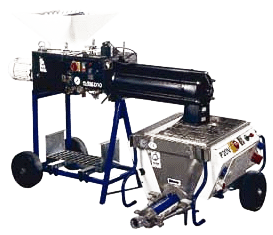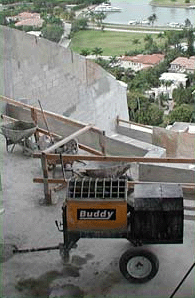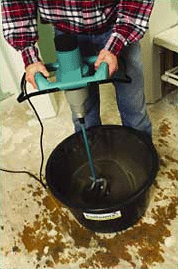Mixer Mania
By Tom Inglesby
 There are more ways to mix a batch of mortar these days than ever before. Touring the trade shows brings up some interesting differences.
There are more ways to mix a batch of mortar these days than ever before. Touring the trade shows brings up some interesting differences.
Mortar and grout ? most masonry jobs need these elements in significant quantities. Some of those jobs are in hard-to-reach areas and others are small enough to make hauling the nine-yard mixer a waste of gas. Luckily, we have companies addressing large and small mixer needs, and some that offer a little more than just enough.
At the recent masonry shows, mixers varying from batch plant sizes and truck-mounted "ready-mix" units, to hand-operated "mix master" units that work in a five-gallon pail were seen. Several companies seemed to have mixers that ranged from small to overwhelming.
For example, m-tec (machine techniques), Milpitas, Calif., offered continuous mixers and mixer/pumps combinations in a wide variety of capacities. Michael Monz, m-tec CEO and President, offered these suggestions: "I would recommend one of our continuous mixers (e.g. D20) for all sites using more than five bags a day. The mixer will not just give you convenience and faster use but it also improves the material quality. You will always get the same consistency without controlling the mixing time (continuous process) and water ratio. Once adjusted, the water is always added to the dry material in the same ratio every time the mixer starts. The material will be prepared in the amount you need and when you need it at a push of a button. This helps to reduce wastage and gives you plenty of always-fresh material."
The m-tec line includes continuous mixers with capacities from five to 25 gal/min (Types D10, D20, D30, D40, D50). The smaller mixers can be fed by bagged material; the higher capacity ones need bulk material in job site silos. Monz believes the advantage of this type of mixer, against batch mixers, is that they guarantee the same consistency and water ratio the whole workday. The operator doesn't have to worry about mixing times and water dosage.
"In addition they can be combined with our pumps," he says, "And a wet mortar probe can start and stop the mixer automatically when material is needed at the point of application. All m-tec mixers operate under one- or three-phase electric power to get a stable rpm ? important for good mix consistency ? and enable a full automatic control between different machines and to reduce noise and pollution."
At the World of Masonry show, m-tec showed a mixer that can mix site sand with a pre-blend compound and water in a continuous process.
Monz notes, "This mixer, called Co-mix, gives you all the benefits of an m-tec continuous mixer as well as the easy use of site sand, which can be delivered in bulk. This will help to reduce transportation costs as only the compound has to be delivered from a dry mix plant; the sand can be bought locally."
And the Beat Goes On
 A fact of life on the job site is that environmental regulations ? and their enforcement ? are getting more stringent. As you move up a building, floor after floor, you find it makes sense to haul the mixer up rather than walk the mortar to the work. That means your mixer needs to be compact, portable and environmentally friendly.
A fact of life on the job site is that environmental regulations ? and their enforcement ? are getting more stringent. As you move up a building, floor after floor, you find it makes sense to haul the mixer up rather than walk the mortar to the work. That means your mixer needs to be compact, portable and environmentally friendly.
Jim Swisher, President of Buddy Equipment, Miami, Fla., explains, "Job site inspections are controlling discharge of slurry, and the inspectors on the job are paying a lot more attention to this than they did in years past. At the end of the day, the mason is not allowed to wash out the equipment the way he or she would like. They have to control this mess they make. That means there tends to be more mortar left in the drum at the end of the mixing day. The next morning the worker begins the ritual I call 'dry cleaning' ? where the mason takes his or her hammer and beats the drum to loosen any mortar that's left from the day before. Then they dump that out and begin to mix."
Contractor Marco Maffolini of Select Masonry, North Miami Beach, Fla., knows you can't just wash the mixer out at the end of the day, letting that water run down 30 flights of stairs. "We kept finding our mixers at upper floors with no way to clean them at the end of the shift. We could only empty a wheelbarrow of water and slurry; any runoff wasn't allowed. So we had to 'dry clean' the mixer ? pound the drum to free up the dried mortar in pieces, load that into the trash chute and then scrape the mixer drum so the paddles wouldn't bind up. It isn't easy, but it meets regulations. That makes the durability and strength of the mixer we use all the more important."
Select Masonry recently bought two mixers from Buddy Equipment, and Swisher thinks he knows why.
"The shape of our drum and the thickness of our material is more resistant than any other mixer on the market," Swisher states. "We put a shape on the back of our drum ? we call it eliminating the dead zone ? that makes the drum so much stronger and resistant to the mason's hammer. When you pound on one side of a piece of steel, in effect you're shot peening it and that tends to deflect and bend the metal. When it bends, it throws off the total alignment of everything in that mixer ? things like the paddle shaft or the relationship of the ends of the paddles to the drum. It ultimately causes failure when the bearings fail, the shaft drops, and the paddles can get so out of position that they rub the drum."
Besides the drum shape and its resistance to getting bent out of shape, the Buddy mixer claims to offer higher performance ? speed of mixing ? than other mixers.
As Swisher says, "You may think you need to own a 12-cubic-foot mixer because you need batches of 12 cubic feet at a time. But with our nine-cubic-foot mixer, you can almost mix two batches in the same amount of time that you would mix one batch in the 12-cubic-footer. So in a similar period of time, from a Buddy, you might realize 18 cubic feet of mixed mortar instead of 12 from the larger, but slower, machine."
This comes in handy at the start of the day. When everybody shows up at the job, there's a tremendous demand for mortar. "That's where the speed comes in," claims Swisher, "because you've got masons who want to get to work but they need their mortar. The speed of your mixer at the beginning of the day is critical. Everybody needs mortar all at the same time."
Bucket of Mud
 Certainly not in the same league with the Buddy or m-tec mixers, the Collomix from Mixing Innovations, New Albany, Ind., might only make sense on smaller jobs. Then again, you don't have to haul it around behind a pickup truck, either. In fact, you can pop it into the trunk of your sedan ? or carry it on the back of your motorcycle!
Certainly not in the same league with the Buddy or m-tec mixers, the Collomix from Mixing Innovations, New Albany, Ind., might only make sense on smaller jobs. Then again, you don't have to haul it around behind a pickup truck, either. In fact, you can pop it into the trunk of your sedan ? or carry it on the back of your motorcycle!
Looking a lot like the rotary mixers used to make bread dough ? but on steroids ? the Collomix is a handheld, motorized mixer that works with a tub or, if you really only need a small amount of mortar, a bucket or pail. Like a mason's Cuisenart, the Collomix is available with a wide selection of shaft-mounted mixing paddles designed to work with materials from paint to aggregate. In addition, mixing units can be single- or double-shaft, with motors running on 110- or 230-Volt lines.
In operation, the Collomix is held by a worker standing over a bucket or tub of material. As simple as mixing cake batter, the unit stirs up the material while water is added. Robin Finklestein, marketing manager for Mixing Innovations, warns masons against thinking of the Collomix as a modified drill.
"The CX Series handheld power mixers are designed to provide high-performance mixing of cement, mortar, screed and other viscous materials used in the masonry, tile and concrete trades," says Finklestein. "The mixers are a significant improvement over the drill in terms of performance and design. Contractors can mix up to 25 gallons (2-1/2 cubic feet of finished material) at one time. The motor is designed for mixing ? not drilling holes ? and the two-speed gear units deliver optimal power in either slow or fast speeds."
Easily portable, the Collomix can even mix on scaffolding if power is available. Try that with a nine-cubic-yard mixer!
Pumping up Profits
Speed in getting the job done can improve profits, but not if the quality goes down as the speed goes up. One way to move mortar to higher levels is by pumping it. M-tec, for example, makes mixers, pumps and combinations of the two.
"The smaller pumps, such as the P20, can only be used for material that contains aggregates of approximately 1/10-inch, as coarser material will reduce the lifetime of the worm pump," comments Monz. "This part can be changed within a few minutes, but of course the maintenance costs will reduce the savings from the use of the pump. The larger model P30 is suitable up to pea-gravel and is therefore recommended for most grouts. This pump can deliver grouts up to 200 feet and more depending on the material."
All m-tec pumps are worm or rotor/stator pumps. The rotor is made out of steel and the stator of a special rubber.
Monz notes, "In general, the lifetime of the rotor is twice that of the life of the stator. This means, to reduce maintenance cost, just change the rotor with every second stator."
Some other rules to follow are:
- Never run the pump without material, as the material lubricates the rotor and stator. If you run the pump without material, the rotor/stator will have to be replaced after only a few minutes!
- Water does not lubricate the pump as well as the material, so clean with as little water as possible and do not use the pump to clean the hoses ? it's better to use water pressure, if available.
- Reduce the hose length to the minimum and straighten the hoses to reduce the pressure and force in the pump.
Not every pump that has paddles inside is also a mixer. For example, take the pump from Thin Line Pump, Acme, Mich.
Charles Partridge, President of Thin Line acknowledges, "Our pump has paddles in it, but you don't use them to mix. They just to keep the mud fluffed up and heading toward the center where the pump pick-up is on the bottom. You put the mixed mortar in the pump and then its variable speed motor allows you to go from zero to two gallons per minute. It's used a lot for cultured stone, thin brick, pavers and we do a lot of restoration with it. Basically, we do large 400,000- to 500,000-sq.-ft. building restoration projects. Bank One Ballpark in Phoenix was 400,000 sq. ft. of thin brick, for example. It will pump 50 feet straight up or 75 feet on the horizontal."
The mortar is mixed in a small barrel mixer ? or in a bucket with the Collomixer ? and then added to the pump in three- to four-gallon batches. You have 30 minutes of pumping before you have to add to the mix.
"I have them running 10 hours a day," says Partridge. "The only thing I tell them to do, since it's a gravity feed pump, is to scrape the sides. The paddles are within one inch of the outside of the drum so they don't actually clean the drum. As the day goes on, you might get dry mortar buildup on the drum so you want to keep it scraped clean."
About the Author
Tom Inglesby is a San Diego-based freelance writer whose work has appeared in numerous online and print publications. He is the winner of the Construction Writers Association's 2002 Boger Award for Special Reports.


















